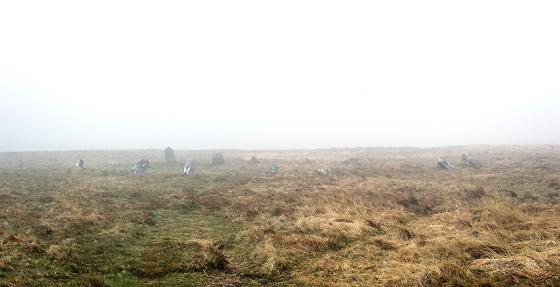




The thatch on the larger houses extends almost to the ground.

Reconstructed forge.

Complex roof structure inside one of the larger houses.

Posts mark the position of further roundhouses.

The inner bank curving towards an entrance (original?) into the settlement.

The inner bank rises to an impressive height on the left.

Inner bank – the main defences. The ditch is long-since filled.

Excavated chevaux-de-frise.

Slight outer earthworks and some suitably Iron Age-ish sheep.

Castell Henllys – Iron Age Hillfort
Chevaux-de-frise – These small (.5m – 1m)stones formed part of the defence structures for Castell Henllys. They stick out of the ground at awkward angles which would make an approach very difficult.


Here we were lucky enough to find a fire still burning at Castell Henllys, my father takes advantage and warms his hands.

Taken 12th April 2003: This is the view of Castell Henllys from A487. I guess it’s just a matter of time before they get my money.





It was not what archaeologists at an ancient Welsh hill-fort expected to find – a mountain of plastic.
More info :
Pembrokeshire is one of the ‘dig destinations’ for archaeology students this summer.
Dozens of students from all over the world are working in the county at a number of excavation sites, a major one being at Castell Henllys Iron Age Fort, which is owned and run by the Pembrokeshire Coast National Park Authority. For over 25 years, students, led by Dr. Harold Mytum, of the University of York, have been returning to Castell Henllys to help unlock more of the secrets of this unique award-winning heritage site.
Phil Bennett, archaeological heritage manager for the National Park, has worked closely with the York University team for many years. “Each year brings new excitements and findings,” he said. “Gradually the fascinating history of the site is pieced together from evidence recovered from the excavation which gives us an insight to life here over 2,000 years ago.”
“The hillfort is brought to life using information based on the many discoveries made by archaeologists during the on-going dig which is now in its 26th year. This is the only Iron Age hillfort in Britain where roundhouses have been reconstructed on their original foundations.”
Dozens of family events are taking place during the summer at Castell Henllys, bringing the past to life and finding out how our ancestors lived. “It is really nice to see children enjoying themselves and learning about the past in such a vibrant way,” added Phil. “At events at Castell Henllys children dress up in Iron Age cloaks and experience daily life in prehistoric times. Older children can actually go and see how archaeological excavations work.” Further details are available from Castell Henllys on 01239 891319 or by checking out the website www.castellhenllys.com
From tenby-today.co.uk/today/options/news/newsdetail.cfm?id=16416
More at
The Western Mail
A 24-year archaeological dig which has transformed Wales’ view of the Iron Age is to be wound up.
...secret stashes of sophisticated artefacts such as querns for grinding corn, spindle whorls for weaving, brooches, spear heads and horse harnesses [were found, and] painstaking sifting at the student training ground each summer has also unearthed several high-class Roman-style goods. This year 50 students led by Harold Mytum, of York University, have already found an almost perfectly preserved fifth-century-BC bowl, as well as glass beads.
“To me this site is very important,” said Dr Mytum yesterday. “It’s the only example of this sort of fort that’s been excavated very extensively. It’s revealed that they are very much more complicated in their design and construction than people thought.
“In Britain it’s up there with two or three other major Iron Age sites people know about such as Danebury in Hampshire. Although it was on the fringes, excavations show that it was not out of touch with the rest of the country. It’s made important changes to our perceptions of Iron Age Britain. It was on coastal trading routes and not perceived as a marginal area.”
This is a cracking place to visit. Visible from the main road (just). Well sign posted with a decent car park and visitor’s centre / shop. The walk to the village from the car park is lovely through the trees and is an easy 10 minute stroll. When I visited myself, Karen and Dafydd were the only ones there and had free roam of the village. Dafydd loved running in an out of the round houses which were furnished with beds, hides, hearths etc. There are old breeds of goats / sheep in the paddocks around the site and it is easy to imagine you are back in the Iron Age. It feels like the inhabitants have just ‘nipped out’ and are due back at any time! Excellent place to visit – well worth the long drive.
The roundhouses blew me away, and the detail of the interiors was wonderous! I loved everything about this place, and apart from the lack of sunshine, it looked and smelled just like being back in an African village: the smoke seeping out through the deep thatched rooves, the inky blackness of the interior of the huts, the smouldering logs, the woven withy fences, the cow shite and mud walls, the dust underfoot, the rough branches holding up essential furnishings, the sense of constant activity needed to maintain the place; rethatching, weaving and so on. I would have been quite happy ‘surviving the iron age’. I felt quite at home here and it rekindled my spirits.
This is the place where “Surviving the Iron Age” was filmed. Luckily, the site is everything the series wasn’t. Get there by 2pm for the excellent guided tour.
Fantastic place – can’t recommend it enough ...
A web site about the excavation of Castell Henllys.
An aerial photo of Castell Henllys taken in 1991. There’s a second (undated) aerial photo on the same site.




























































































